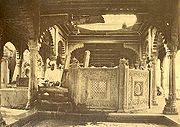
Gyanvapi Mosque
Encyclopedia
Gyanvapi Mosque is a mosque built by Mughal Emperor Aurangazeb. It is located north of Dashaswamedh Ghat, near Lalita Ghat along the river Ganga in Varanasi
at the original site of Kashi Vishwanath temple.
, dedicated to the Hindu god Shiva
(also called Vishwanath), has a special and unique significance in the spiritual history of India. It is considered to be one of the holiest places of Hinduism.
The temple has been destroyed and rebuilt a number of times. After being rebuilt in 1585, Aurangzeb ordered its demolition in 1669 and constructed Gyanvapi Mosque, which still exists alongside the temple.
The temple was reconstructed in 1780.
 The minarets are 71 meters high and used to dominated the Varanasi skyline till a 1948 flood caused it to collapse. Material from the destroyed temple was reused by Aurangzeb while building the Gyanvapi Mosque. The mosque shows evidence of original Hindu temple in its foundation, columns and rear.
The minarets are 71 meters high and used to dominated the Varanasi skyline till a 1948 flood caused it to collapse. Material from the destroyed temple was reused by Aurangzeb while building the Gyanvapi Mosque. The mosque shows evidence of original Hindu temple in its foundation, columns and rear.
The old temple wall was also incorporated as part of the walls of the mosque. The deliberately retained remnants of the temple are described to be "a warning and an insult to Hindu feelings". The façade is modeled on the Taj Mahal
's entrance.
The Kashi Vishwanath Temple was rebuilt in 1780 besides the mosque and the two structures have existed in harmony since then, separated by a barricade of iron staves and chicken wire. The Gyanvapi — the well of knowledge — is situated between the temple and the mosque. The well is believed by Hindus to be the location where the sacred Shiva linga icon of the temple was hidden, before the temple was razed by Aurangzeb.
, who consider it symbolic of Islamic iconoclasm. After the demolition of the Babri Mosque
— which was allegedly built on the site of a sacred Hindu temple by Aurangzeb's ancestor — in December 1992, about a thousand policemen guard the Kashi Vishwanath temple/Gyanvapi mosque site.
The mosque is functional and receives protection under Places of Worship (Special Provisions) Act, 1991.
Varanasi
-Etymology:The name Varanasi has its origin possibly from the names of the two rivers Varuna and Assi, for the old city lies in the north shores of the Ganga bounded by its two tributaries, the Varuna and the Asi, with the Ganges being to its south...
at the original site of Kashi Vishwanath temple.
History
The Kashi Vishwanath Temple of VaranasiVaranasi
-Etymology:The name Varanasi has its origin possibly from the names of the two rivers Varuna and Assi, for the old city lies in the north shores of the Ganga bounded by its two tributaries, the Varuna and the Asi, with the Ganges being to its south...
, dedicated to the Hindu god Shiva
Shiva
Shiva is a major Hindu deity, and is the destroyer god or transformer among the Trimurti, the Hindu Trinity of the primary aspects of the divine. God Shiva is a yogi who has notice of everything that happens in the world and is the main aspect of life. Yet one with great power lives a life of a...
(also called Vishwanath), has a special and unique significance in the spiritual history of India. It is considered to be one of the holiest places of Hinduism.
The temple has been destroyed and rebuilt a number of times. After being rebuilt in 1585, Aurangzeb ordered its demolition in 1669 and constructed Gyanvapi Mosque, which still exists alongside the temple.
The temple was reconstructed in 1780.
Construction

The old temple wall was also incorporated as part of the walls of the mosque. The deliberately retained remnants of the temple are described to be "a warning and an insult to Hindu feelings". The façade is modeled on the Taj Mahal
Taj Mahal
The Taj Mahal is a white Marble mausoleum located in Agra, India. It was built by Mughal emperor Shah Jahan in memory of his third wife, Mumtaz Mahal...
's entrance.
The Kashi Vishwanath Temple was rebuilt in 1780 besides the mosque and the two structures have existed in harmony since then, separated by a barricade of iron staves and chicken wire. The Gyanvapi — the well of knowledge — is situated between the temple and the mosque. The well is believed by Hindus to be the location where the sacred Shiva linga icon of the temple was hidden, before the temple was razed by Aurangzeb.
Concerns
The mosque faces a threat of being target of some Hindus and Hindu organizations like Vishwa Hindu Parishad and Rashtriya Swayamsevak SanghRashtriya Swayamsevak Sangh
Rashtriya Swayamsevak Sangh or National Patriotic Organization), also known the Sangh, is a right-wing Hindu nationalist, paramilitary, volunteer, and allegedly militant organization for Hindu males in India...
, who consider it symbolic of Islamic iconoclasm. After the demolition of the Babri Mosque
Babri Mosque
The Babri Mosque , was a mosque in Ayodhya, a city in the Faizabad district of Uttar Pradesh, on Ramkot Hill . It was destroyed in 1992 when a political rally developed into a riot involving 150,000 people, despite a commitment to the Indian Supreme Court by the rally organisers that the mosque...
— which was allegedly built on the site of a sacred Hindu temple by Aurangzeb's ancestor — in December 1992, about a thousand policemen guard the Kashi Vishwanath temple/Gyanvapi mosque site.
The mosque is functional and receives protection under Places of Worship (Special Provisions) Act, 1991.

